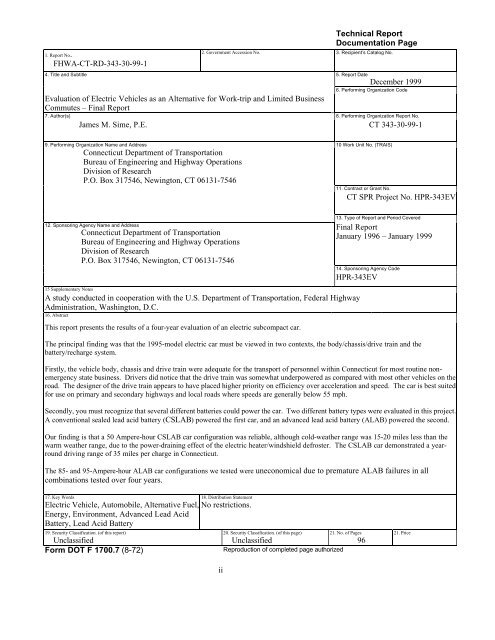Evaluation of Electric Vehicles as an Alternative for Work Trip and ...
Evaluation of Electric Vehicles as an Alternative for Work Trip and ...
Evaluation of Electric Vehicles as an Alternative for Work Trip and ...
Create successful ePaper yourself
Turn your PDF publications into a flip-book with our unique Google optimized e-Paper software.
1. Report No.<br />
FHWA-CT-RD-343-30-99-1<br />
2. Government Accession No.<br />
Technical Report<br />
Documentation Page<br />
3. Recipient’s Catalog No.<br />
4. Title <strong>an</strong>d Subtitle 5. Report Date<br />
December 1999<br />
6. Per<strong>for</strong>ming Org<strong>an</strong>ization Code<br />
<strong>Evaluation</strong> <strong>of</strong> <strong>Electric</strong> <strong>Vehicles</strong> <strong>as</strong> <strong>an</strong> <strong>Alternative</strong> <strong>for</strong> <strong>Work</strong>-trip <strong>an</strong>d Limited Business<br />
Commutes – Final Report<br />
7. Author(s) 8. Per<strong>for</strong>ming Org<strong>an</strong>ization Report No.<br />
James M. Sime, P.E. CT 343-30-99-1<br />
9. Per<strong>for</strong>ming Org<strong>an</strong>ization Name <strong>an</strong>d Address 10 <strong>Work</strong> Unit No. (TRAIS)<br />
Connecticut Department <strong>of</strong> Tr<strong>an</strong>sportation<br />
Bureau <strong>of</strong> Engineering <strong>an</strong>d Highway Operations<br />
Division <strong>of</strong> Research<br />
P.O. Box 317546, Newington, CT 06131-7546<br />
11. Contract or Gr<strong>an</strong>t No.<br />
CT SPR Project No. HPR-343EV<br />
12. Sponsoring Agency Name <strong>an</strong>d Address<br />
Connecticut Department <strong>of</strong> Tr<strong>an</strong>sportation<br />
Bureau <strong>of</strong> Engineering <strong>an</strong>d Highway Operations<br />
Division <strong>of</strong> Research<br />
P.O. Box 317546, Newington, CT 06131-7546<br />
15 Supplementary Notes<br />
A study conducted in cooperation with the U.S. Department <strong>of</strong> Tr<strong>an</strong>sportation, Federal Highway<br />
Administration, W<strong>as</strong>hington, D.C.<br />
16. Abstract<br />
This report presents the results <strong>of</strong> a four-year evaluation <strong>of</strong> <strong>an</strong> electric subcompact car.<br />
13. Type <strong>of</strong> Report <strong>an</strong>d Period Covered<br />
Final Report<br />
J<strong>an</strong>uary 1996 – J<strong>an</strong>uary 1999<br />
14. Sponsoring Agency Code<br />
HPR-343EV<br />
The principal finding w<strong>as</strong> that the 1995-model electric car must be viewed in two contexts, the body/ch<strong>as</strong>sis/drive train <strong>an</strong>d the<br />
battery/recharge system.<br />
Firstly, the vehicle body, ch<strong>as</strong>sis <strong>an</strong>d drive train were adequate <strong>for</strong> the tr<strong>an</strong>sport <strong>of</strong> personnel within Connecticut <strong>for</strong> most routine nonemergency<br />
state business. Drivers did notice that the drive train w<strong>as</strong> somewhat underpowered <strong>as</strong> compared with most other vehicles on the<br />
road. The designer <strong>of</strong> the drive train appears to have placed higher priority on efficiency over acceleration <strong>an</strong>d speed. The car is best suited<br />
<strong>for</strong> use on primary <strong>an</strong>d secondary highways <strong>an</strong>d local roads where speeds are generally below 55 mph.<br />
Secondly, you must recognize that several different batteries could power the car. Two different battery types were evaluated in this project.<br />
A conventional sealed lead acid battery (CSLAB) powered the first car, <strong>an</strong>d <strong>an</strong> adv<strong>an</strong>ced lead acid battery (ALAB) powered the second.<br />
Our finding is that a 50 Ampere-hour CSLAB car configuration w<strong>as</strong> reliable, although cold-weather r<strong>an</strong>ge w<strong>as</strong> 15-20 miles less th<strong>an</strong> the<br />
warm weather r<strong>an</strong>ge, due to the power-draining effect <strong>of</strong> the electric heater/windshield defroster. The CSLAB car demonstrated a yearround<br />
driving r<strong>an</strong>ge <strong>of</strong> 35 miles per charge in Connecticut.<br />
The 85- <strong>an</strong>d 95-Ampere-hour ALAB car configurations we tested were uneconomical due to premature ALAB failures in all<br />
combinations tested over four years.<br />
17. Key Words<br />
18. Distribution Statement<br />
<strong>Electric</strong> Vehicle, Automobile, <strong>Alternative</strong> Fuel, No restrictions.<br />
Energy, Environment, Adv<strong>an</strong>ced Lead Acid<br />
Battery, Lead Acid Battery<br />
19. Security Cl<strong>as</strong>sification. (<strong>of</strong> this report)<br />
Uncl<strong>as</strong>sified<br />
Form DOT F 1700.7 (8-72)<br />
ii<br />
20. Security Cl<strong>as</strong>sification. (<strong>of</strong> this page)<br />
Uncl<strong>as</strong>sified<br />
Reproduction <strong>of</strong> completed page authorized<br />
21. No. <strong>of</strong> Pages<br />
96<br />
21. Price
















